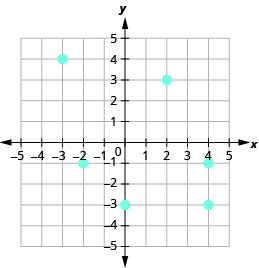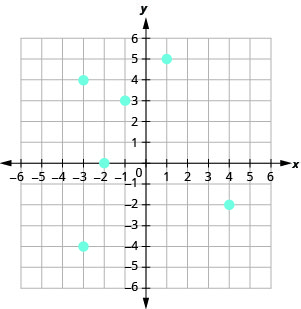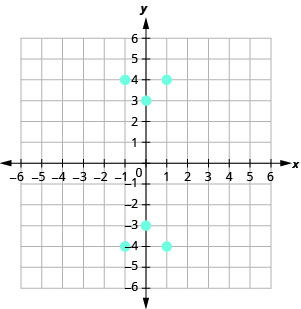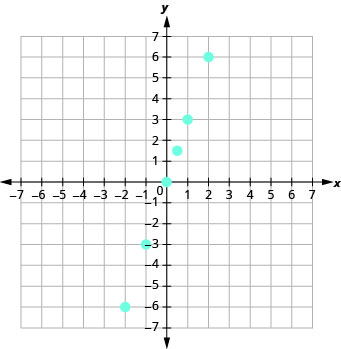2-1 Practice Relations And Functions
2.1E: Exercises - Relations and Functions
- Folio ID
- 48332
Practice Makes Perfect
Discover the Domain and Range of a Relation
In the following exercises, for each relation a. find the domain of the relation b. detect the range of the relation.
one. \({\{(one,four),(two,8),(3,12),(4,16),(5,20)}\}\)
- Answer
-
a. \({\{one, 2, three, four, 5}\}\) b. \({\{4, 8, 12, xvi, 20}\}\)
2. \({\{(1,−two),(2,−4),(three,−6),(4,−8),(5,−10)}\}\)
iii. \({\{(1,7),(5,3),(vii,9),(−2,−iii),(−ii,viii)}\}\)
- Answer
-
a. \({\{1, v, 7, −2}\}\) b. \({\{7, 3, 9, −3, 8}\}\)
4. \({\{(11,iii),(−2,−vii),(iv,−8),(4,17),(−6,9)}\}\)
In the following exercises, use the mapping of the relation to a. list the ordered pairs of the relation, b. discover the domain of the relation, and c. find the range of the relation.
5.
- Respond
-
a. (Rebecca, January 18), (Jennifer, Apr 1), (John, Jan 18), (Hector, June 23), (Luis, February 15), (Ebony, April vii), (Raphael, November half-dozen), (Meredith, August nineteen), (Karen, August 19), (Joseph, July xxx)
b. {Rebecca, Jennifer, John, Hector, Luis, Ebony, Raphael, Meredith, Karen, Joseph}
c. {January 18, April i, June 23, February 15, April 7, Nov 6, Baronial 19, July xxx}
vi.
7. For a woman of top \(v'4''\) the mapping below shows the corresponding Body Mass Index (BMI). The body mass index is a measurement of trunk fat based on height and weight. A BMI of \(18.5–24.9\) is considered good for you.
- Answer
-
a. \((+100, 17. 2), (110, 18.9), (120, xx.6), (130, 22.3), (140, 24.0), (150, 25.7), (160, 27.five)\) b. \({\{+100, 110, 120, 130, 140, 150, 160,}\}\) c. \({\{17.two, 18.ix, 20.6, 22.3, 24.0, 25.7, 27.5}\}\)
8. For a man of meridian \(5'11''\) the mapping below shows the corresponding Torso Mass Alphabetize (BMI). The body mass index is a measurement of body fat based on tiptop and weight. A BMI of \(18.v–24.nine\) is considered salubrious.
In the post-obit exercises, utilize the graph of the relation to a. list the ordered pairs of the relation b. find the domain of the relation c. find the range of the relation.
9.

- Answer
-
a. \((2, 3), (4, −3), (−2, −1), (−3, 4), (4, −1), (0, −three)\) b. \({\{−3, −2, 0, 2, 4}\}\)
c. \({\{−3, −one, 3, 4}\}\)
x.

xi.

- Respond
-
a. \((1, 4), (1, −iv), (−1, 4), (−1, −4), (0, 3), (0, −3)\) b. \({\{−1, 0, 1}\}\) c. \({\{−four, −3, 3,4}\}\)
12.

Make up one's mind if a Relation is a Part
In the following exercises, employ the prepare of ordered pairs to a. decide whether the relation is a role, b. find the domain of the relation, and c. find the range of the relation.
13. \( {\{(−3,ix),(−two,4),(−1,1), (0,0),(1,1),(ii,4),(3,ix)}\}\)
- Answer
-
a. yes b. \({\{−3, −2, −1, 0, 1, two, 3}\}\) c. \({\{nine, iv, 1, 0}\}\)
14. \({\{(9,−3),(4,−2),(1,−1),(0,0),(one,one),(4,2),(9,3)}\}\)
15. \({\{(−3,27),(−ii,8),(−i,1), (0,0),(ane,1),(2,viii),(3,27)}\}\)
- Answer
-
a. yes b. \({\{−3, −2, −ane, 0, 1, 2, 3}\}\) c. \({\{0, ane, viii, 27}\}\)
16. \({\{(−3,−27),(−2,−8),(−1,−1), (0,0),(1,1),(2,8),(3,27)}\}\)
In the following exercises, utilize the mapping to a. make up one's mind whether the relation is a function, b. find the domain of the function, and c. find the range of the function.
17.
- Respond
-
a. yes b. \({\{−three, −2, −1, 0, 1, ii, three}\}\) c. \({\{0, 1, 2, 3}\}\)
18.
19.
- Answer
-
a. no b. {Jenny, R and y, Dennis, Emily, Raul} c. {RHern and ez@country.edu, JKim@gmail.com, Raul@gmail.com, ESmith@state.edu, DBroen@aol.com, jenny@aol.cvom, R and y@gmail.com}
20.
In the following exercises, make up one's mind whether each equation is a function.
21. a. \(2x+y=−3\)
b. \(y=10^2\)
c. \(x+y^2=−5\)
- Respond
-
a. aye b. yep c. no
22. a. \(y=3x−5\)
b. \(y=ten^3\)
c. \(2x+y^2=4\)
23. a. \(y−3x^3=2\)
b. \(x+y^two=3\)
c. \(3x−2y=half dozen\)
- Answer
-
a. yes b. no c. yes
24. a. \(2x−4y=eight\)
b. \(−4=x^two−y\)
c. \(y^2=−x+five\)
Observe the Value of a Function
In the following exercises, evaluate the office: a. \(f(2)\) b. \(f(−ane)\) c. \(f(a)\).
25. \(f(10)=5x−3\)
- Answer
-
a. \(f(ii)=7\) b. \(f(−i)=−8\) c. \(f(a)=5a−3\)
26. \(f(x)=3x+4\)
27. \(f(x)=−4x+ii\)
- Answer
-
a. \(f(2)=−vi\) b. \(f(−ane)=vi\) c. \(f(a)=−4a+2\)
28. \(f(x)=−6x−3\)
29. \(f(10)=x^two−x+3\)
- Answer
-
a. \(f(2)=five\) b. \(f(−1)=5\)
c. \(f(a)=a^2−a+3\)
30. \(f(10)=x^two+x−2\)
31. \(f(10)=2x^2−x+3\)
- Answer
-
a. \(f(ii)=ix\) b. \(f(−one)=6\)
c. \(f(a)=2a^2−a+3\)
32. \(f(ten)=3x^2+ten−two\)
In the following exercises, evaluate the function: a. \(g(h^2)\) b. \(g(x+ii)\) c. \(yard(x)+thou(2)\).
33. \(g(ten)=2x+i\)
- Answer
-
a. \(g(h^2)=2h^two+1\)
b. \(g(x+2)=4x+5\)
c. \(g(x)+chiliad(2)=2x+vi\)
34. \(g(ten)=5x−8\)
35. \(g(x)=−3x−2\)
- Answer
-
a. \(thousand(h^two)=−3h^2−two\)
b. \(one thousand(10+2)=−3x−viii\)
c. \(g(x)+one thousand(2)=−3x−10\)
36. \(thousand(10)=−8x+two\)
37. \(g(x)=3−10\)
- Answer
-
a. \(one thousand(h^2)=3−h^ii\)
b. \(k(x+2)=one−x\)
c. \(chiliad(ten)+g(2)=iv−x\)
38. \(grand(x)=vii−5x\)
In the following exercises, evaluate the function.
39. \(f(ten)=3x^two−5x\); \(f(two)\)
- Respond
-
2
40. \(g(x)=4x^2−3x\); \(thou(3)\)
41. \(F(x)=2x^two−3x+i\); \(F(−one)\)
- Answer
-
6
42. \(Thou(ten)=3x^2−5x+2\); \(One thousand(−2)\)
43. \(h(t)=2|t−5|+4\); \(f(−4)\)
- Answer
-
22
44. \(h(y)=3|y−one|−3\); \(h(−iv)\)
45. \(f(ten)=x+2x−ane\); \(f(2)\)
- Answer
-
4
46. \(g(x)=x−2x+2\); \(g(4)\)
In the post-obit exercises, solve.
47. The number of unwatched shows in Sylvia'southward DVR is 85. This number grows by 20 unwatched shows per calendar week. The function \(North(t)=85+20t\) represents the relation between the number of unwatched shows, N, and the fourth dimension, t, measured in weeks.
a. Determine the independent and dependent variable.
b. Observe \(N(4)\). Explicate what this result means
- Respond
-
a. t IND; N DEP
b. \(N(4)=165\) the number of unwatched shows in Sylvia'southward DVR at the fourth week.
48. Every day a new puzzle is downloaded into Ken's business relationship. Right now he has 43 puzzles in his business relationship. The function \(N(t)=43+t\) represents the relation between the number of puzzles, N, and the time, t, measured in days.
a. Determine the contained and dependent variable.
b. Observe \(N(thirty)\). Explain what this result means.
49. The daily cost to the printing company to print a book is modeled by the role \(C(x)=three.25x+1500\) where C is the total daily cost and x is the number of books printed.
a. Determine the independent and dependent variable.
b. Notice \(N(0)\). Explicate what this consequence ways.
c. Discover \(N(1000)\). Explain what this result ways.
- Reply
-
a. x IND; C DEP
b. \(North(0)=1500\) the daily cost if no books are printed
c. \(N(1000)=4750\) the daily cost of printing 1000 books
50. The daily cost to the manufacturing company is modeled by the function \(C(x)=7.25x+2500\) where \(C(x)\) is the total daily cost and 10 is the number of items manufactured.
a. Make up one's mind the contained and dependent variable.
b. Find \(C(0)\). Explain what this outcome means.
c. Notice \(C(1000)\). Explicate what this result means.
Writing Exercises
51. In your own words, explicate the difference betwixt a relation and a function.
52. In your own words, explain what is meant by domain and range.
53. Is every relation a office? Is every office a relation?
54. How do y'all find the value of a function?
Cocky Check
a. After completing the exercises, employ this checklist to evaluate your mastery of the objectives of this section.
b. Later looking at the checklist, do yous think you are well-prepared for the next section? Why or why non?
2-1 Practice Relations And Functions,
Source: https://math.libretexts.org/Courses/Community_College_of_Denver/MAT_1320_Finite_Mathematics/02%3A_More_About_Functions/2.01%3A_Relations_and_Functions/2.1E%3A_Exercises_-_Relations_and_Functions
Posted by: wallaceuple1986.blogspot.com


0 Response to "2-1 Practice Relations And Functions"
Post a Comment